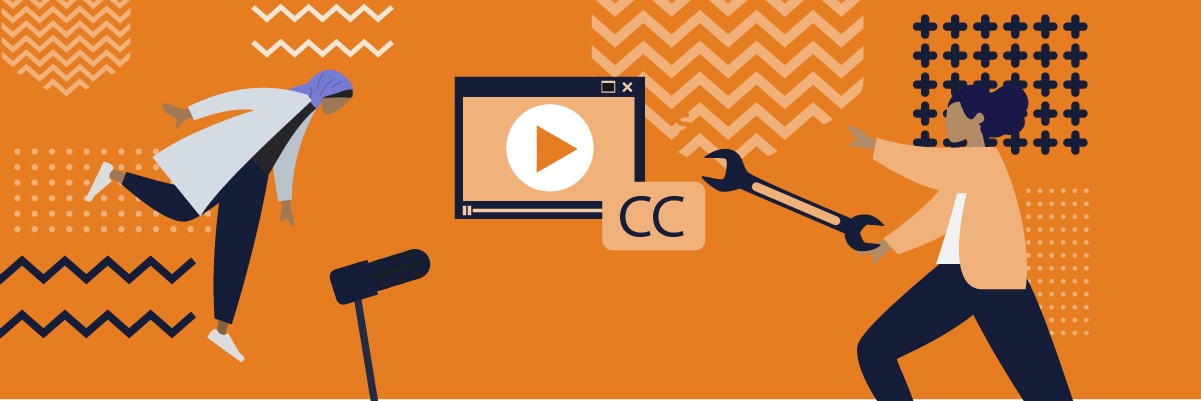Captioning is not always mandatory, but a lot of viewers love having them on screen.
Captions are applied in TV, movies, video streaming services, and video games – allowing the audience to closely follow what is happening on the screen.
Captioning remains an absolutely necessary addition to your video content – and in some cases, mandatory.
They are particularly helpful for audiences that are hard of hearing.
In this article, you will learn why and when captioning is mandatory, and how to apply it to your videos.
Types of Captions
When we say captions, we don’t mean the catchy quotes that you put under your Instagram uploads. Captions, in this case, are time-synchronized texts that transcribe the audio file on a video track.
There are multiple methods of captioning, but first, let’s outline the differences between captions and subtitles.
Captions vs Subtitles
Are they the same thing?
On some level, ‘captions’ is just another way to say ‘subtitles.’ However, the two concepts are slightly different.
Captions are transcription texts; subtitles are translations.
This means that while captioning is mainly to benefit those who cannot hear the audio, subtitles are made for audiences that cannot understand the language.
Open Captioning
This is one of the oldest forms of captioning.
Open captions come already added (burnt) on the video file and cannot be turned off, and they are mostly applicable where the close captioning feature is not accessible.
Why Use Open Captioning?
With open captions, your audience doesn’t have to figure out how to turn the captions on and off.
Captions that are permanently burnt into the video are also great for social media videos.
On platforms such as Facebook, a lot of viewers watch their videos on silent. Open captions will immediately pop up on the screen and keep the attention of the viewer.
The Downside of Open Captions
Since they are permanently burnt onto the video, open captions can be restricting as well as distracting.
In as much as they are helpful (and mandatory for audiences with hearing loss), some viewers might want to watch their content without captions.
Open captions are also tied to the quality of the video.
If the original video quality is poor, then the captions might be difficult to see and read.
When to Use Open Captioning
It is best to use open captions when captioning is mandatory. When making or presenting content to people who have a hearing disability, open captioning is the only way to go.
These permanent captions are also handy when playing videos in an outdoor setting.
Cinemas and foreign films often include open captions to further engage their audiences.
And who says captions are just for videos?
Want to provide additional information concerning your meme or gif? Use open captions to fully communicate your message to your audience.

Closed Captioning
This type of captioning allows the viewer to turn the text on and off. In this context, therefore, the viewer is in charge of whether they get to see the captions or not.
Why Use Closed Captions?
The flexibility of closed captions makes them appealing to most viewers. The viewer has the option to turn the subtitles off if they become too distracting.
Closed captions are also easier to edit and re-upload.
These captions exist in a separate file and can be stored in multiple formats as well as played in different forms of media.
With open captions, changing something means uploading the video file all over again.
Where to use Closed Captions
Closed captions have a wider use case compared to open captions.
The best example is YouTube.
Facebook videos, streaming services like Netflix, T.V programs, and video games also use closed captioning techniques.
There are two types of closed captioning:
Online Captioning
Also called real-time captioning, this technique is particularly useful in live broadcasts.
The captions are generated as the footage is aired. Sporting events or any live programs on TV all rely on real-time captioning.
Online captioning employs of use of ASR (Automatic Speech Reorganization) software to convert audio into text, hence saving a lot of time and effort.
However, ASR tends to have a high error margin, so always check the output for any incomprehensible phrases.
Off-line Captioning
This technique involved adding captions on video footage while it is being recorded. Prime TV programs and educational media use this captioning method.
Offline captioning is much more efficient than online captioning because there is enough time to embed the text into the video.
Captioning Styles
Roll-Up
This style of captioning is synchronized and verbatim.
In roll-up captioning, every speaker is identified on the text.
It works like this:
The text moves from the bottom to the top of the screen (or vice-versa), and as new text appears at the top, the bottom text disappears.
Pop-On
The text appears on the screen, remains for several seconds then disappears.
Paint-On
The words move from left to right and appear to be painted on the screen.
When Is Captioning Mandatory?
Captioning is mandatory depending on the following factors:
- What type of content are you producing?
- Who is the audience?
- What geographical locations are you targeting and what are the laws of the place?
Laws for Mandatory Captioning
The Americans with Disabilities Act bans discrimination against people with disabilities. Failing to add captions to your videos can be seen as discrimination to those with hearing disabilities – and this can attract quite a hefty fine.
Certain platforms such as YouTube may have regulations that require one to add captions to their video.
Individual companies may also put-up guidelines that govern their video production.
Finally, as a video editor, your client may give explicit instructions for captions to be added to their video.
Captions may not always be mandatory, but they are still essential for video.
Why is Captioning Necessary?
For the Hard of Hearing (and Listening)
Deaf audiences depend on captions to consume audio content.
One of the main reasons for captioning is to give these audiences full access to video content, including the background noises and speaker differentials.
Captioning is also used to assist students with learning disabilities to improve their reading skills.
Easier Consumption of Video
With captions, you can watch your videos even in a sensitive environment. You can watch your online videos while taking the bus, or during that boring office meeting.
With captions, even noisy environments can’t stop you from enjoying your favorite content.
Captioning your videos is a great way to capture your viewers’ attention.
Global Access
Captions and subtitles broke the global video market wide open.
Now, your videos can be watched in any language across the world – as long as you get your native translation right.
Help the Online Learners
Educational content is easier to consume and understand when it has captions.
Learners can read along as the video plays and master the spellings of the more technical words.
Market your Brand
Captioning videos for your brand will increase viewership.
Both viewers and search engines use specific keywords to find your content. Captioning your videos makes it easier for people to find them, hence making your content rank higher on search engines.

Keep the Attention
When you have captions for your videos, there is a high chance that your viewers will watch your video to the end.
The audience will definitely remember what happened in the video too.
Captions will open your content up to bigger and better audiences. Your content will be accessible to deaf audiences, learners with disabilities, and even foreign viewers.
How to Add Captions to Your Videos
You can do it yourself, use speech-to-text software, or hire a freelancer to add captions to your videos.
Use Google Drive
You can add captions using Google Drive and it’s absolutely free!
All you have to is sign up with Google Drive, upload your video, and follow these instructions:
- Once the video is uploaded, click on the more icon then select the Manage Caption Tracks.
- Click on the option Add New Caption Tracks.
- Select the file format for the caption, which will be the SRT format. While on this step also select the language and a file name for the caption track.
- Click upload.
With Google Drive, you get access to ready captions.
To switch off the captions, go back to More > Manage caption Tracks, find your caption track and click on it to switch it off.
Use YouTube Editor
To use this, you need to be a registered YouTube member and channel owner.
- Upload your video
- Open the video and click on the CC button under it.
YouTube allows you to alter the captions depending on what you like, choose the language you want and also tune the time duration. You also get to choose if you want to transcribe the content yourself or use ready captions.
- Once you are done click on Save.
Use a Transcription Software
Transcription software is used to create professional-looking captions.
Some are free, and others only have demo versions that allow users to try some features before buying.
Examples of transcription platforms include:
- FTW Transcriber
- Express Scribe
- Inqscribe
- Dragon Naturally Speaking
Read more about these platforms and their advantages on our guide: Audacity Transcription: The All-Inclusive Software for Transcription Projects.
Conclusion
Captioning is essential to video production. Aside from attracting new audiences and keeping their attention, captions are also a great way to elevate the impact of your brand.
The rate of video consumption is only getting higher – don’t miss out on all the benefits of captioning.
If you decide to hire someone to do your captions, ensure they are a professional who understands the different styles and types of captions.
Get in touch with the best captioning experts today!










